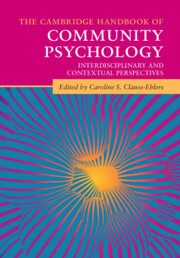Book contents
- The Cambridge Handbook of Community Psychology
- The Cambridge Handbook of Community Psychology
- Copyright page
- Dedication
- Contents
- Figures
- Tables
- Contributors
- Foreword
- Part I Foundational Concepts
- Part II Research, Assessment, and Program Evaluation
- 6 Conducting Culturally Responsive Community Needs Assessments
- 7 Comprehensive Evaluation of a Rural School Mental Health Program
- 8 Constructive Diversity Pedagogy for Challenging Classroom Dialogues
- 9 Critical Language Ethnography as a Community-Centered Research Paradigm
- Part III Community Psychology in Action
- Part IV Where Do We Go from Here?
- Index
- References
7 - Comprehensive Evaluation of a Rural School Mental Health Program
from Part II - Research, Assessment, and Program Evaluation
Published online by Cambridge University Press: 16 December 2021
- The Cambridge Handbook of Community Psychology
- The Cambridge Handbook of Community Psychology
- Copyright page
- Dedication
- Contents
- Figures
- Tables
- Contributors
- Foreword
- Part I Foundational Concepts
- Part II Research, Assessment, and Program Evaluation
- 6 Conducting Culturally Responsive Community Needs Assessments
- 7 Comprehensive Evaluation of a Rural School Mental Health Program
- 8 Constructive Diversity Pedagogy for Challenging Classroom Dialogues
- 9 Critical Language Ethnography as a Community-Centered Research Paradigm
- Part III Community Psychology in Action
- Part IV Where Do We Go from Here?
- Index
- References
Summary
Promoting youth resilience and well-being in vulnerable rural populations requires a coordinated approach that builds connections between schools, families, community resources, and school mental health clinicians. Emphasizing a community psychology and ecological systems approach, this chapter describes how one school–community–university partnership improved school mental health (SMH) programming and reduced the impacts of adverse childhood experiences (ACEs) in eight rural South Carolina elementary schools. This approach included delivering a continuum of evidence-based SMH services, helping families navigate community resources to address concrete needs that would otherwise function as barriers to student well-being and achievement, building community-level ACE awareness and capacity for resiliency promotion, and conducting a thorough mixed-methods evaluation to highlight program achievements and areas for improvement. Information on the nature and outcomes of the project and strategies for conducting rich evaluations for similar regional programs are presented. Finally, a new model – the Empower Action Model – for organizations interested in developing a functional, coordinated plan of action for improving equity, health, and well-being in their communities is introduced.
Keywords
- Type
- Chapter
- Information
- The Cambridge Handbook of Community PsychologyInterdisciplinary and Contextual Perspectives, pp. 137 - 160Publisher: Cambridge University PressPrint publication year: 2021



